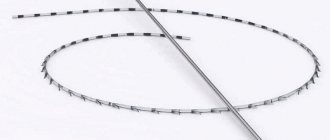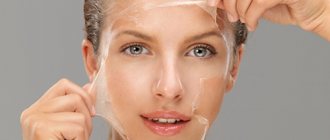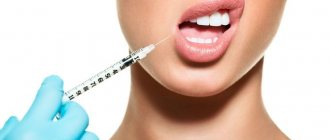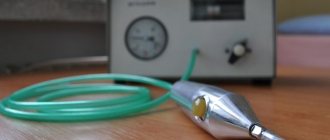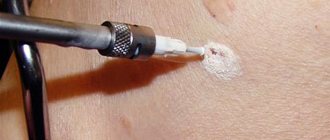- Reasons for deletion
- Pros and cons of the method
- Progress of the procedure
- After cauterization with nitrogen
- Skin care
- Photos before and after
- Side effects
- Contraindications
- Price of the procedure
A mole, papilloma or wart is most often a benign neoplasm. Some people are not bothered by the presence of these nevi on the skin at all, others experience aesthetic discomfort, for others it is also the cause of physical discomfort (friction against clothing, soreness, etc.). In any case, know: if you have any nevi on your face or body, you must monitor them to avoid the risk of them becoming malignant.
Wart on hand
Effective and low-traumatic removal is possible using the following hardware methods :
- cauterization with liquid nitrogen (cryodestruction);
- “evaporation” with a laser beam (vaporization);
- destruction by high frequency current (electrocoagulation);
- cauterization using high-frequency radio waves (radiocoagulation).
What a wart, papilloma, mole is, how they differ, what to pay attention to, and whether you need to get rid of them is written in detail in the article on laser removal.
In this material we will consider the method of cauterization of tumors with liquid nitrogen.
What are the risks?
In most cases, moles are harmless new growths that do not cause discomfort or health problems.
However, some moles, under the influence of external unfavorable factors, can degenerate into a malignant neoplasm.
Provoking factors include:
- prolonged exposure of the mole to sunlight;
- regular friction with clothing or mechanical damage.
Removing moles with liquid nitrogen is a common and popular procedure, the advantages of which are simplicity, painlessness and affordability.
Using the cryodestruction method, various types of neoplasms are removed - flat, convex and hanging moles.
But freezing moles is associated with certain risks - burns or incomplete removal of neoplasm tissue and the need for repeated procedures. This is due to the inability to control the depth of nitrogen exposure.
Therefore, cryodestruction is more often used to remove flat moles. And hanging and convex moles are removed by other methods - electrocoagulation, laser or radio waves.
Surgical removal of a mole
Excision of the formation with a scalpel is considered the most painful. If the mole is on the face, this method is not advisable.
After surgery, the temperature may increase.
Surgical removal of moles requires not only the surgeon's qualifications, but also special care for the excision site after surgery. During the rehabilitation process, the patient will have to apply gauze bandages with an antibiotic or other healing ointment, changing them regularly (2 times a day). During the entire healing period, it is prohibited to swim or wet the removal site.
Indications
Photo: bleeding nevus
The risk of nevus degeneration into a malignant formation is the main reason for removal. But not all moles need to be removed.
There are certain indications for tumor removal:
- increase/decrease of a mole;
- change in the shape of a mole;
- change in color of a mole;
- painful sensations in the area of the mole;
- bleeding moles;
- detection of precancerous transformations in a mole by cytological examination;
- a sharp increase in the number of moles on the skin.
Removal is also carried out to eliminate an aesthetic defect if the mole is located in a visible place.
It should be borne in mind that nitrogen only affects moles that are located on the surface and do not penetrate into the deeper layers of the skin.
What it is?
The process of removing a mole using cold involves exposing an area of human skin to liquid nitrogen, the temperature of which reaches -190°C. Under the influence of cold, the water in the formation cells freezes and collapses. Further restoration of cells is impossible and the process of complete death of the affected tissue occurs. The procedure itself is very quick (maximum time no more than 10 minutes) and almost painless. Some pain is possible in areas of increased sensitivity - on the pads of the fingers, for example.
Danger of the procedure
Before deciding to carry out such a procedure, you need to familiarize yourself with the possible problems. Like any operation, cryodestruction carries a number of dangers, although the risk of their occurrence is low. The reason for the danger lies in the removal method itself - exposure to low temperatures. The danger of cryodestruction is as follows:
The disadvantage of cryodestruction of nevi is the impossibility of submitting biomaterial for histology.
- Complete destruction of the mole at the cellular level. As a result of the procedure, this is the best indicator, but the inability to examine a removed nevus may lead to the miss of a disease such as melanoma.
- The depth of exposure to nitrogen is difficult to control. Nitrogen is applied using a cotton swab or a special needle. In any case, it is difficult to predict the depth of formation and not damage healthy skin with low temperatures.
These are the most likely negative situations that arise during the cryodestruction process. The probability of their occurrence is small, but not reduced to zero. Every patient who decides to do this must be mentally prepared for possible pain during the procedure. And sometimes even a repeated visit to the cryo-center, since a mole cannot always be removed in one session.
Indications for removal
To avoid negative results, you should consult a doctor before the procedure, who will confirm the necessity and safety of the procedure. Sometimes nevi cause physical discomfort when wearing everyday clothes or have an unaesthetic appearance. In this case, the decision is made by the patient independently, i.e. it is not binding. But there are a number of signs when removing a mole is necessary:
- a sharp increase in their number on the body;
- painful sensations;
- bleeding;
- change in color of the nevus or the skin around it;
- itching and redness;
- change in shape and size.
Based on these signs, it is recommended to consult a doctor as soon as possible to check the formation for malignancy. Ignoring and neglecting the disease leads to its complications. The doctor takes a sample for analysis and gives a referral for cryodestruction. Timely visit to the hospital and cryo-center will help prevent the development of melanoma.
How does cold affect a mole?
The freezing point of water is 0°C. Under the influence of liquid nitrogen with a temperature of about -190 ° C, instant freezing and crystallization of the water contained in the tissue cells of the mole occurs. Dehydration of cells and intercellular space occurs, and blood supply to tissues is disrupted.
At the same time, ions and products of cellular metabolism accumulate in the cells, which, upon reaching a certain toxic threshold, cause destruction of cell membranes. Protein (denaturation) and fat structures are destroyed.
All irreversible changes lead to the impossibility of further functioning of cellular structures and the death of tissues exposed to nitrogen.
Cold destroys not only the tumor tissue, but also the nerve endings localized in the treatment area. Therefore, the freezing procedure is absolutely painless.
Features of cauterization of moles with nitrogen
Cryodestruction has successfully replaced the surgical scalpel. The peculiarity of cryotherapy is that the skin remains intact during the process. Only the local area of the nevus is damaged, in the worst case - 1-2 mm around the area.
Removing birthmarks, warts and papillomas with liquid nitrogen has become popular for the following reasons:
- no pain;
- speed of operation;
- affordable price;
- low probability of contracting an infection;
- absence of marks, scars;
- Suitable for the treatment of hanging, flat birthmarks.
The disadvantage of cryotherapy is its inaccuracy. The doctor conducts an examination before prescribing the procedure. The required depth of treatment and the area of influence are determined. The findings determine the appropriate method of therapy.
Deep damage to the dermis leaves a scar.
Complete healing of the skin after exposure to nitrogen lasts up to 1.5 months. During the first week, swelling appears at the site of manipulation, the mole changes color, and the skin thickens. At weeks 2 and 3, a dark crust becomes noticeable. You cannot remove it, tear it off, or keep it under the sun yourself. By 4-5 weeks, the skin is completely restored without traces of surgery.
Carrying out the procedure
Methods for removing moles with liquid nitrogen
Cryodestruction of a mole is performed in two ways:
- Cotton swab. Used in case of superficial localization and small size of the mole. A swab soaked in liquid nitrogen is applied to the tumor for a short time (up to 3 minutes). Numbness occurs, and then the tissues completely die.
- Using a cryodestructor. A cryodestructor is a special device with which a needle is inserted under the skin, connected to a sensor that controls the temperature.
Photo: cryodestruction procedure
Through a needle, liquid nitrogen is supplied to the lower layers of the epidermis. The sensor allows you to control the temperature at the site of exposure and promptly interrupt freezing.
Using a cryodestructor, large moles and neoplasms that penetrate into the deeper layers of the skin are removed.
The procedure lasts from 30 seconds to 3 minutes. The duration is determined by the required depth of exposure and the area of the treated area. It does not cause pain, so it is performed without anesthesia.
Removing moles using the radio wave method
Removal of moles by this method is usually performed using a radio wave installation of the Surgitron type. The method is painless and effective; with not very large areas of treatment, it leaves almost no marks on the skin.
High-frequency radio wave vibrations are transmitted through tissue and cause minimal damage to the surrounding skin surface, less than a surgical scalpel. After radio wave treatment, a small wound remains on the body. After some time, it heals, leaving a small, gradually disappearing spot. The healing process takes from 3 days to 2 weeks, depending on the size of the treatment area.
The radiosurgical method is used to eliminate deep formations on the skin:
- warts,
- keratosis,
- fibroids,
- moles,
- facial capillaries or spider veins,
- papillomas,
- scars after acne.
Rehabilitation and recovery
The rehabilitation period after cryodestruction lasts up to 2 months.
During the procedure, the affected area of the skin hardens and turns white and loses sensitivity. In this case, burning and tingling sensations may be noted.
Healing period
Healing occurs in several stages:
- on the first day after the procedure, inflammation develops caused by the death of mole cells and the formation of granulation tissue (crust);
- after 7 days, regeneration processes begin - new epithelial tissue cells begin to form;
- tissue restoration is completed after 3–6 weeks - a new skin is formed at the site of the removed mole without signs of previous intervention.
Care
After the mole is removed, a crust forms on the treated area, preventing infection of the wound surface. The main thing is that the resulting crust disappears on its own. Under no circumstances should it be removed mechanically. You should also not wet the surface with water or treat it with creams.
The first days after the procedure, you can treat the wound with a weak solution of potassium permanganate, which has an antiseptic effect and dries the wound.
If pathological signs appear during healing, you should immediately consult a doctor.
These signs include:
- continuous bleeding from the wound;
- redness of the skin around the wound with a gradual increase in the area of redness;
- severe swelling of the skin around the wound;
- discharge of pus;
- increase in body temperature.
7-14 days after the mole is removed, the crust falls off, revealing tender, young skin.
It is important not to injure it or expose it to sunlight. To speed up recovery, you can treat the skin with a wound-healing gel or cream (Actovegin, rescuer and other drugs).
After three weeks, the skin is completely restored and no further treatment is required.
The only exception is patients with sensitive skin, who often experience itching on the treated areas of the skin. To eliminate the unpleasant symptom, you can use an ointment with an antipruritic effect (sinaflane, beloderm) once. After using them, all unpleasant sensations disappear.
The doctor should give recommendations on skin care and prescribe the necessary medications.
Photo: after cauterization with liquid nitrogen
How does skin restoration proceed?
After the procedure is completed, the area where liquid nitrogen was applied loses sensitivity and turns white. Some patients experience a rare tingling and slight burning sensation.
In the first few days after the procedure, the cells quickly die, and a flaky crust forms at the site of the growth. There is slight inflammation and redness of the skin. It is forbidden to tear off the crust or treat it with various creams.
You should also try to wet it less. It is recommended to treat the wound with a potassium solution, which will dry it and protect it from germs.
After 10-14 days, the skin begins to recover. The layers of the epidermis are restored gradually - from the deepest to the top.
Complete healing of the skin at the site of removal is completed 5-6 months after cryodestruction.
Throughout the healing period, the wound must be protected from contamination and injury.
Contraindications, complications and side effects
Contraindications to cryodestruction include:
- inflammatory and acute infectious diseases;
- inflammatory processes in the area of intended treatment;
- malignant nature of the neoplasm;
- individual intolerance to liquid nitrogen;
- convulsions and epileptic seizures;
- pregnancy.
Complications after cryodestruction
There are no unpleasant consequences of removing moles with liquid nitrogen if the procedure is performed correctly.
The following complications are very rarely possible:
- damage to healthy tissues - due to incorrect calculation of time, depth and area of exposure;
- allergic reaction to cold - with incomplete collection of data on the patient’s history of diseases;
- infection – if rehabilitation rules are not followed (infection of the wound can result from the patient’s independent mechanical removal of the crust that has formed at the treatment site).
Photo: scar on the skin
Side effects
The main side effects of cryodestruction include:
- formation of scars and scars;
- change in skin pigmentation (usually the skin at the treatment site is lighter).
Skin care after removal
During the first week, the wound is covered with a dark crust, which generally serves as a protection, and which in no case should be forcibly removed. It covers the damaged area until new skin grows. Also, you should not get it wet, smear it with creams, cosmetic masks, etc.
So, you’ve removed a mole – what should you use to treat it? On the first day, it is very good to treat the damaged area of skin with potassium permanganate - the effect is disinfecting and drying. During the processing process itself, it is necessary to maintain sterility. This means using disposable supplies. Hands must be worn with disposable medical gloves; if they are not available, hands must be treated with alcohol or Chlorhexidine.
Pros and cons
Cryodestruction, like any other procedure, has a number of advantages and disadvantages.
Advantages:
- painlessness;
- simplicity of the method;
- speed of the procedure;
- affordability;
- minimal risks of complications.
Flaws:
- inability to affect the deep layers of the skin (nevus may not be completely removed);
- inability to control the depth of exposure, which leads to damage to healthy tissues and burns;
- long rehabilitation period (about 2 months);
- the need for several sessions when removing large moles;
- risk of scar formation.
It is especially unpleasant if scars appear after removal of a mole on the face. Having gotten rid of this aesthetic drawback, another problem arises that will have to be dealt with.
Efficiency of cryodestruction
Efficiency is the main positive factor in favor of this method of mole removal. Most formations are eliminated with nitrogen in the first session. An important positive aspect of cryodestruction is the absence of a scar at the site of the removed nevus. Thanks to deep penetration, the formation is destroyed deeply and completely. Therefore, the cryodestruction method also works well when removing various papillomas and warts. The procedure can be done for both children and adults.
Prices in Moscow clinics
Prices for removing moles with liquid nitrogen in Moscow clinics average 1,000 – 1,500 rubles . The cost depends on the area of the treated area and the number of moles removed. The location and reputation of the clinic and the level of professionalism of the doctor influence the price formation.
| Clinic | Price (in rubles) | Procedure |
| Deltaclinic | 1 100 | Electrocoagulation of moles up to 0.5 cm |
| Family doctor | from 1 500 | Nevus removal with laser |
| Medinnova | from 950 | Burning out the tumor with liquid nitrogen |
| Health Clinic | from 800 | Cryodestruction of nevus |
Solution of potassium permanganate and "Fukortsin"
Antiseptic solutions are intended to prevent suppuration of the place where the mole was removed. What to process? More often than others, potassium permanganate and Fukortsin are used. Potassium permanganate or potassium permanganate is a strong oxidizing agent and even when diluted retains its properties. The potassium permanganate solution should be 0.1-0.5%. This means consumption of 6-8 of its crystals per liter of water. It should be poured into a glass container and be warm. If it is impossible to count, make the solution “by eye” - after mixing it should have the color of red wine.
After preparation, you need to dip a cotton swab into the solution and gently wipe the surface of the former mole. The surrounding skin should also be wiped.
"Fukortsin" is a ready-made pharmaceutical solution of dark red color. Has antimicrobial and fungicidal effects. It can also be applied, but it should not be allowed to come into contact with mucous membranes. Treatment frequency is 1-3 times a day.
How else to treat the mole removal site? It is possible to use solutions of “Chlorhexidine”, “Furacilin”, brilliant green, iodine, chamomile infusion, hydrogen peroxide.
After about a week, the existing crust, in the absence of complications, falls off on its own, and fresh new skin remains in its place. It can easily be injured, so you need to protect it from damage and ultraviolet radiation. Over time, its color evens out. It should be protected regardless of the time of year - before going outside, lubricate your skin with sunscreen. Additional skin treatment after removal of a mole is needed in case of infection in the form of weeping, pus, itching, redness, etc.
Laser removal of papillomas
Removal of epithelial tumors with a laser is a fairly quick and easy-to-perform procedure. Its advantages include:
- minimal risk of injuring healthy tissue;
- no pain;
- Only local anesthesia is required;
- short rehabilitation period;
- does not require hospitalization;
- low chance of infection since there is no contact with blood or open wound;
- rapid healing, as it disinfects and cauterizes the wound;
- short intervention time;
- low probability of relapse;
- absence of scars and cicatrices.
Preparation for the procedure
Despite the simplicity of implementation, laser removal of papillomas is still a surgical intervention, therefore, before proceeding with direct treatment, the patient must undergo general blood and urine tests, blood tests for hormones, allergens and biochemistry. In many cases, biomaterial is taken for a biopsy to determine the type of HPV. 10 - 14 days before the manipulation, you should avoid medicinal baths, tanning, including in a solarium, and applying cosmetics to the affected area. If the papilloma interferes with normal activities, you should cover it with a band-aid.
